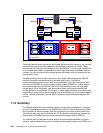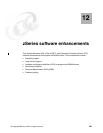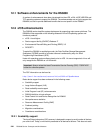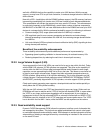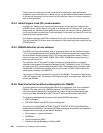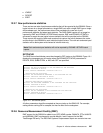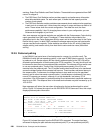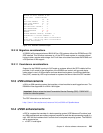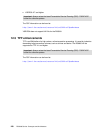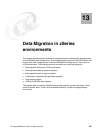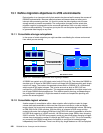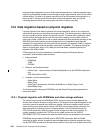
248 DS6000 Series: Concepts and Architecture
sections: Extent Pool Statistics and Rank Statistics. These statistics are generated from SMF
record 74 subtype 8:
The ESS Extent Pool Statistics section provides capacity and performance information
about allocated disk space. For each extent pool, it shows the real capacity and the
number of real extents.
The ESS Rank Statistics section provides measurements about read and write operations
in each rank of an extent pool. It also shows the number of arrays and the array width of all
ranks. These values show the current configuration. The wider the rank, the more
performance capability it has. By changing these values in your configuration, you can
influence the throughput of your work.
Also, new response and transfer statistics are available with the Postprocessor Cache Activity
report generated from SMF record 74 subtype 5. These statistics are provided at the
subsystem level in the Cache Subsystem Activity report and at the volume level in the Cache
Device Activity report. In detail, RMF provides the average response time and byte transfer
rate per read and write requests. These statistics are shown for the I/O activity (called host
adapter activity) and transfer activity from hard disk to cache and vice-versa (called disk
activity).
12.2.9 Preferred pathing
In the DS6000, host ports have a fixed assignment to a server (or controller card). The
DS6000 will notify the host operating system, in this case DFSMS (device support), if a path
is preferred or not. Device support will then identify preferred paths to the IOS. I/Os will be
directed to preferred paths to avoid crossing the PCI-X connection. The only time this will not
be honored is when there are no preferred paths available. The software will then switch over
to use non-preferred paths. There will be a slight performance penalty if the I/O is not
executed over the preferred path. The I/O request and the data would have to be transferred
across the bridge interface that connects both servers. These transfers add some latency to
the response time. Furthermore, the bridge interface is also used to mirror the persistent
memory and for other inter-server communication. It could become a bottleneck if too many
normal I/O requests ran across it, although it is a high bandwidth, low latency, PCI-X
connection. If the IOS support for preferred pathing is not implemented, sequential reads may
drop by up to 50%. The response time in low stress environments may also increase by up to
10% to 20%.
New messages will inform the user when all preferred or the last preferred path is varied
offline. Figure 12-2 shows the output from the DEVSERV PATHS command. Now, this output
displays preferred paths information.
Figure 12-2 DEVSERV PATHS command showing preferred pathing
Figure 12-3, shows the output from the DISPLAY DEV command. The output has been
enhanced to display the path attributes as preferred path (PF) or non-preferred path (NP).
DS P,9E02
IEE459I 09.14.03 DEVSERV PATHS 943
UNIT DTYPE M CNT VOLSER CHPID=PATH STATUS
RTYPE SSID CFW TC DFW PIN DC-STATE CCA DDC ALT CU-TYPE
9E02,33909 ,O,000,339R53,38=+ 42=+
PATH ATTRIBUTES PF NP
1750 9900 Y YY. YY. N SIMPLEX 02 02 2107
************************ SYMBOL DEFINITIONS ************************
O = ONLINE + = PATH AVAILABLE
PF = PREFERRED NP = NON-PREFERRED



